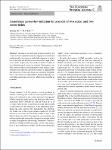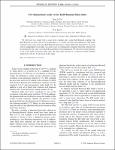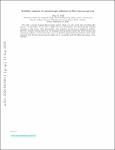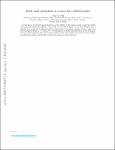Browsing by Author Tuan Q. Do
Showing results [1 - 10] / 10
In this paper, we study a non-canonical extension of a supergravity-motivated model acting as a vivid counterexample to the cosmic no-hair conjecture due to its unusual coupling between scalar and electromagnetic fields. In particular, a canonical scalar field is replaced by the string-inspired Dirac–Born–Infeld one in this extension. As a result, exact anisotropic inflationary solutions for this Dirac–Born–Infeld model are figured out under a constant-roll condition. Furthermore, numerical calculations are performed to verify that these anisotropic constant-roll solutions are indeed attractive during their inflationary phase. |
In this paper, we extend a recent proposed model of two scalar and two vector fields to a hyperbolic inflation scenario, in which the field space of two scalar fields is a hyperbolic space instead of a flat space. In this model, one of the scalar fields is assumed to be a radial field, while the other is set as an angular field. Furthermore, both scalar fields will be coupled to two different vector fields, respectively. As a result, we are able to obtain a set of exact Bianchi type I solutions to this model. Stability analysis is also performed to show that this set of anisotropic solutions is indeed stable and attractive during the inflationary phase. This result indicates that the ... |
Inspired by an interesting counterexample to the cosmic no-hair conjecture found in a supergravity-motivated model recently, we propose a multi-field extension, in which two scalar fields are allowed to non-minimally couple to two vector fields, respectively. This model is shown to admit an exact Bianchi type I power-law solution. Furthermore, stability analysis based on the dynamical system method is performed to show that this anisotropic solution is indeed stable and attractive if both scalar fields are canonical. Nevertheless, if one of the two scalar fields is phantom then the corresponding anisotropic power-law inflation turns unstable as expected. |
Effect of non-canonical scalar fields on the CMB imprints of the anisotropic inflation will be discussed in details in this paper. In particular, we are able to obtain the general formalism of the angular power spectra in the scalar perturbations, tensor perturbations, cross-correlations, and linear polarization in the context of the anisotropic inflation model involving non-canonical scalar fields. Furthermore, some significant numerical spectra will be plotted using the most recent data of Planck as well as the BICEP2 and Keck array. As a result, we find a very interesting point that the TT spectra induced by the tensor perturbations as well as by the linear polarization will increa... |
We will focus on a model with a scalar-vector coupling and a scalar Kalb-Ramond coupling. The Kalb-Ramond two-form is known to be equivalent to a
U
1
gauge one-form in five dimensions. The model with both scalar-vector and scalar Kalb-Ramond interactions is hence effectively equivalent to an action with two independent vector fields. As a result, a new set of spherically symmetric black hole solutions will be presented for the scalar-vector Kalb-Ramond theory in five dimensions. We will show that the presence of the scalar fields and gauge fields affect the black hole structure in a nontrivial manner. Related implications will also be discussed in this paper. |
In this paper, we propose an extension of the Ricci-inverse gravity, which has been proposed recently as a very novel type of fourth-order gravity, by introducing a second order term of the so-called anticurvature scalar as a correction. The main purpose of this paper is that we would like to see whether the extended Ricci-inverse gravity model admits the homogeneous and isotropic Friedmann–Lemaitre–Robertson–Walker metric as its stable inflationary solution. However, a no-go theorem for inflation in this extended Ricci-inverse gravity is shown to appear through a stability analysis based on the dynamical system method. As a result, this no-go theorem implies that it is impossible to ... |
In this paper, we study the so-called Ricci-inverse gravity, which is a very novel type of fourth-order gravity proposed recently. In particular, we are able to figure out both isotropically and anisotropically inflating universes to this model. More interestingly, these solutions are shown to be free from a singularity problem. However, stability analysis based on the dynamical system method shows that both isotropic and anisotropic inflation of this model turn out to be unstable against field perturbations. This result implies a no-go theorem for both isotropic and anisotropic inflation in the Ricci-inverse gravity. |
We study a recent proposed Ricci-inverse gravity, which is a very novel type of fourth-order gravity. In particular, we are able to figure out both isotropically and anisotropically inflating universes to this model. More interestingly, these solutions are free from a singularity problem. However, stability analysis based on the dynamical system method shows that both isotropic and anisotropic inflation of this model turn out to be unstable against field perturbations. This result indicates that the Ricci-inverse gravity might not be compatible with the inflationary phase of the universe. |
In this paper, we extend our investigation of the validity of the cosmic no-hair conjecture within non-canonical anisotropic inflation. As a result, we are able to figure out an exact Bianchi type I solution to a power-law {\it k}-inflation model in the presence of unusual coupling between scalar and electromagnetic fields as −f2(ϕ)FμνFμν/4. Furthermore, stability analysis based on the dynamical system method indicates that the obtained solution does admit stable and attractive hairs during an inflationary phase and therefore violates the cosmic no-hair conjecture. |
In this paper, we extend our investigation of the validity of the cosmic no-hair conjecture within non-canonical anisotropic inflation. As a result, we are able to figure out an exact Bianchi type I solution to a power-law k-inflation model in the presence of unusual coupling between scalar and electromagnetic fields as −f2(ϕ)FμνFμν/4. Furthermore, stability analysis based on the dynamical system method indicates that the obtained solution does admit stable and attractive hairs during an inflationary phase and therefore violates the cosmic no-hair conjecture. Finally, we show that the corresponding tensor-to-scalar ratio of this model turns out to be highly consistent with the observa... |








